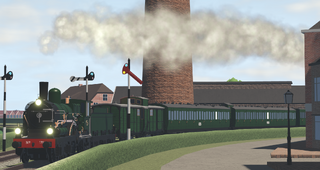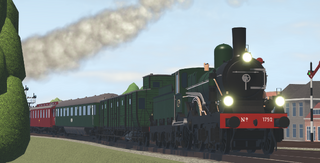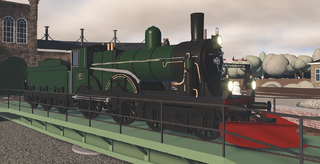 | |
| NS 1700 | |
|---|---|
| by Supersnel11 | |
| Price | ƒ15.000 |
| Level | 3 |
| Statistics | |
| Type | Passenger |
| Top Speed | 100 km/h |
| Weight | 86 tons |
| Capacity | 275 tons |
| Passenger Capacity | 1 first class 1 second class |
| Length | 16,4 meters |
The NS 1700 was a class of Dutch 2'B (4-4-0) express locomotives. Some of these locomotives from the early days of the 20th century lasted until the dusk of Dutch steam traction.
Variants
The NS 1700 is only available in Nederlandsche Spoorwegen green. During the winter updates of 2022 and 2024 it received a snow plough livery.
Historical details
SS 801-935
In order to pull the increasingly heavy passenger trains, the Staatsspoorwegen (SS) designed a locomotive based on their 301-475 series that was put into service in 1899. Much like the 'Grote Groene', these machines were a big success. They pulled the most important trains until 1910, when the SS 700 (later NS 3700) series entered service.
The first 125 built by Beyer, Peacock and Company and Werkspoor delivered two more sets of five. The engines were delivered without superheaters. A trial was done with SS 856 around 1912, but this unsuccessful so the locomotive got a regular firebox again. A second trial with 865 and 889 was started a 30 year period in which a majority of the SS 800s received superheaters.
The 861/67/95, 900/8 and 916 were rebuilt in 1916.
NS 1700
Once the SS and HSM merged into NS, the engines were renumbered to NS 1701-1825. The large-scale rebuilds didn't start until 1921 and was halted in 1932 after exactly 100 locomotives were rebuilt, due to financial troubles. The two prototypes (865 & 889, by now with their NS numbers 1765 & 1789) were updated to be the same as the rest in 1934 and '35.
The first eight superheated 1700s mostly ran trains from Zwolle. When more became available, they were spread across various depots including Nijmegen, Utrecht and Leeuwarden. Other important depots, Amersfoort, Arnhem, Groningen, Den Bosch and Roosendaal, got some superheated 1700s too, later. During the second half of the 1930s, these locomotives could also be found at Amsterdam and Maastricht. They were mostly used on local trains, but were also put on the occasional express and (fast) goods trains. One or two were even used on the "steamdiesel" services between Rotterdam and Utrecht, during the years that the new diesel multiple-units still had some teething troubles and the NS 3700s were not yet allowed on it.
During the war years, when the 3700s and 3900s had to be put on different jobs, the superheated 1700s took over their heavy work. In those years they pulled plenty of express trains, composited of the heaviest, four-axle rolling stock, right on time.

A decision was made to distinguish the 1700s without a superheater from those that did have one in 1941. The ones with a superheater kept their number whilst the superheater-less were renumbered to the series 1300/1400. Although the series number changed, the order was preserved. This created large gaps in the numbering.
NS 1345 and NS 1392 received their superheaters in 1942 and 1943, much later than the others, which was a trick of NS to save personnel in the Tilburg workshop from having to go work in Germany. Once they got superheaters installed, they also got their old numbers back.
Many 1700s were either missing or damaged after the war. Of the 106 1700s that were still in service in 1944, 49 were in Germany. Five of those (1745/70/88, 1817 & 1824) were inside the Russian occupation zone and did not return. They were administratively written off in the 1950. Out of the remaining 101 locomotives, ten (1711/17/22/43/55/86, 1803/08/22 & 1830) were deemed unfit for repair and were written off in 1947.
The 91 locomotives that were retrievable and repairable stayed in service at first but were slowly written off throughout the 1950s. They had the advantage of a low axle load, which allowed them access to all sorts of lines where the heavier machines could not go. Until the arrival of the "Blue angels", they were by far the best and most common locomotives on local- and branchlines, especially in the North and East of the Netherlands. Because of that, it took NS until 1957 to get rid of the last one.
NS 1794
One machine, 1794 was then used as a stationary boiler in Arnhem, where it drove back and forth a couple metres each day, under her own power, to refuel. On November 1st, 1958, she was on her way from Arnhem to Rotterdam Feijenoord for an inspection/overhaul but, as luck would have it, she passed president-director of the Railways, F. Q. den Hollander, who was taking a ride in NS 20 'Kameel'. On his orders, her regulator key was removed when it arrived. After that, she still functioned as stationary boiler in Arnhem for a bit, now needing a shunting engine to move her around. She was scrapped in June of 1959.
Technical details
General details
The NS 1700 were equipped with Westinghouse brakes and a connection for steam heating on the back of the tender. The steam dome was secured by Adams security. From 1918 onwards, they were equipped with pre-heater with a heating surface of 9,2 m² and a pump with a capacity of 120 litres a minute.
During the NS era, the entire class was slowly equipped with Deuta-speedometers. After 1933, they got independent Henry brakes. Whenever the cylinder blocks had to be renewed after 1935, they were replaced with a new design that had straight steam channels.
The 1706 and 1792 were used for the 'sproeitrein', a short train which sprayed chemicals along the track to kill weeds, in the 1950s. They had a small cab mounted left of the smokebox for it.
Poppet valves
In the 1920s and 1930s, the superheated 1700s were used for experimentation with poppet valves. It was hoped that these would use steam more efficiently than the traditional slide valves.
The first to be tested was the Lenz poppet valve gear. It was fitted to the 1780 in 1926 and the 1723 and 1725 a year later. The Lentz valves were driven by the Hackworth valve gear. The smokestack on these three was moved to the very front of the smokebox. These tests were, apparently, a failure. The Lentz system was replaced back to slide valves with Walschaerts valve gear.
The second system to be tested was the Meier Mattern system. Meier Mattern was employed as the chief of the design department of Werkspoor, a Dutch factory for rolling stock. The design of this valve system was based on a mechanism used in diesel engines. It was fitted to the 1752 and 1777 in 1929. Both locomotives had to be driven with the utmost care, but even that failed to make this system a success. The pair was refitted with standard slide valves and Walschaerts valve gear in 1930.
The third and last system to be tested was an upgraded version of the Lentz system. This was fitted to NS 1779 in 1936, but this was reversed two years later.
A combination of commonly occurring leaks, unchanged cylinders and the temperature of the superheated steam not being high enough to justify a poppet valve system made it so all three of the trialled systems failed.
Superheating
The trial of superheating with SS 856 in 1912 failed terribly. The most important reason was that the higher steam temperature caused lubrication problems with the slide valves, which made them deteriorate quickly.
For the second trial, not only the boilers of 865 and 889 were renewed, but also their cylinder blocks. The slide valves were replaced with piston valves and the Stephenson valve gear was changed to Walschaerts. To make room for the piston valves, the boiler was put 190 mm higher. The valves were lubricated by a mechanical Wakefield lubricator.
The locomotives that were rebuild after 1916 received a cylinder block with yet another changed design. The cylinder diameter was increased and the Stephenson's valve gear was replaced with Walschaerts again. The boiler of these machines had to be placed another 95 mm higher. The lubrication of the valves and slides was done by a Friedmann lubricator on these.
The higher boilers resulted in design change of the heart-shaped windows.
Trivia
- The NS 1700 is the cheapest locomotive you can unlock for Gulden, and is a direct upgrade to the similar NS 1300.
- The NS 1700 has received multiple model rebuilds, each rebuild with its own unique differences, akin to how much the real life counterparts ended up so vastly unique.
- Ironically, the NS 1700 has a lower tractive effort than SS 326, which is the predecessor to the NS 1700.
- In version 0.5.12, there was a snow plow added to the NS 1700 during the winter season of 2022.
- The snow plow has returned during the 2024 winter update.
- The NS 1700 has been available since launch, version 0.1.
Gallery
-
An unidentified NS 1700 in the Dokmuiden curve.
-
NS 1752 climbs the hill onto the Voorlem rail bridge.
-
The 1700 with its plow livery.



